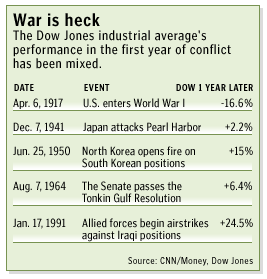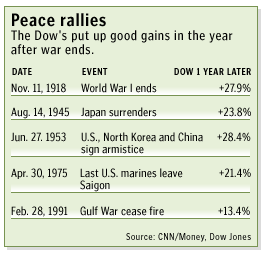NEW YORK (CNN/Money) -
"Buy to the sound of cannons, sell to the sound of trumpets," Lord Nathan Rothschild said in 1810 and who can argue with that? After all, it's when investors are fearful that stocks usually are values, and when they're fat and happy that stocks are overpriced.
But good as Rothschild's advice seems, investors, who are considering following it in these days when war with Iraq seems imminent, should consider that when it comes to actual cannons, the American experience of the past 100 years argues that buying stocks isn't such a good idea. Take a look at Dow Jones industrial average's returns in the first year of the United States' five major conficts in the twentieth century and you get a mixed picture.

Yes, buying stocks at the outset of the 1991 Persian Gulf War would give you big gains -- the Dow rose 24.5 percent over the next year. But in the year following the U.S. declaration of war against Germany in 1917, the Dow fell 16.6 percent. The Dow gained 15 percent in the year following the outbreak of the Korean war. The gains in the year following the Pearl Harbor attack and the Tonkin Gulf Resolution were tepid.
Stack them all up, and the Dow's average annual gain following war is 6.3 percent. Not exactly the sort of return you'd give a ticker tape parade for.
No, it's not a very deep statistical sample, and even figuring out when to say a war "started" is difficult. But the varied returns in war's first year suggest that the idea that buying into the teeth of war brings good gains -- a notion whose popularity may be linked to the surge stocks saw in the first days of the Gulf War -- is flawed. Investors who think that buying at the outset of conflict with Iraq is a good idea may wish they hadn't.
"I don't think you can draw any conclusions from what's happened historically," said Larry Rice, vice president at Janney Montgomery Scott. "There are so many extraneous geopolitical concerns now, all these things that could buffett the market either way."

The real key to how the market reacts to war, thinks Kirlin Securities chief market strategist Tony Dwyer, lies in how sentiment is heading into it. If investors are overly optimistic that the war will be short-lived, then the only surprises that they can get will be negative. If, as was the case in the Gulf War, they're expecting something worse than what they get, stocks can do very well.
But gauging where that sentiment is has been impossibly hard. Technically, the market appears neither "oversold" or "overbought" -- in other words, it's in a muddle. Chicago Board Options Exchange's Volatility Index (also called the "Vix"), a popular measure for getting a handle on investors' level of worry, is high but not at the extremes that it's hit in times of real fear. In such an enviroment, thinks Dwyer, trying to figure out where stocks will head on the outbreak of war is "a pure guess."
| Related Stories
|

|
|
|
|
And even if there is an initial rally, there are still dangers. Rice believes, for example, that there are many investors who are waiting to sell on a war rally. Such a raft of sellers could mean that any rally wouldn't last long.
Now, what about those trumpets? Turns out the conventional wisdom looks wrong there, as well. In the year following every one of the endings of America's 20th century conflicts, the Dow has had double-digit percentage gains with an average return of 23 percent. Investors may be richer for keeping their powder dry until war's last shot is fired.

|

